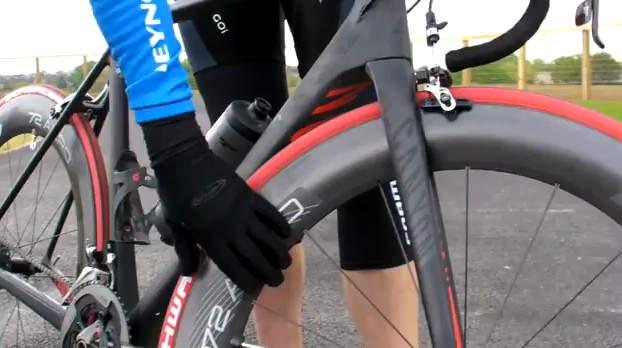- News
- Reviews
- Bikes
- Components
- Bar tape & grips
- Bottom brackets
- Brake & gear cables
- Brake & STI levers
- Brake pads & spares
- Brakes
- Cassettes & freewheels
- Chains
- Chainsets & chainrings
- Derailleurs - front
- Derailleurs - rear
- Forks
- Gear levers & shifters
- Groupsets
- Handlebars & extensions
- Headsets
- Hubs
- Inner tubes
- Pedals
- Quick releases & skewers
- Saddles
- Seatposts
- Stems
- Wheels
- Tyres
- Tubeless valves
- Accessories
- Accessories - misc
- Computer mounts
- Bags
- Bar ends
- Bike bags & cases
- Bottle cages
- Bottles
- Cameras
- Car racks
- Child seats
- Computers
- Glasses
- GPS units
- Helmets
- Lights - front
- Lights - rear
- Lights - sets
- Locks
- Mirrors
- Mudguards
- Racks
- Pumps & CO2 inflators
- Puncture kits
- Reflectives
- Smart watches
- Stands and racks
- Trailers
- Clothing
- Health, fitness and nutrition
- Tools and workshop
- Miscellaneous
- Buyers Guides
- Features
- Forum
- Recommends
- Podcast
TECH NEWS
 paul lew talks wheels
paul lew talks wheelsVideo: Reynolds Cycling wheels guru Paul Lew talks aerodynamics & sidewinds
Paul Lew, the chief aero engineer at Reynolds Cycling, recently talked road.cc through the latest Reynolds wheel range, dubbed simply Aero. In particular, Lew described how his latest design tackle the bugbear of deep-section wheels, stability and handling in cross-winds.
Paul Lew is a former pro triathlete, an aero expert and a composites engineer – a genuine big cheese in the world of bicycle design. He set up Lew Racing and is with Reynolds Cycling. When he’s not reinventing the bike wheel he's been known to work on unmanned aircraft for the US government – drones, to you and me.
The Reynolds Cycling Aero wheel range was launched this year and uses their Dispersive Effect Termination (DET) rim design that was first introduced on the really expensive RZR 92 wheels. There are three rim depths, 58, 72 and 90mm, and prices start from £2,099. Expensive, yes, but half the price of the aforementioned RZR 92 wheels.
What is DET? Well, if you watch the video above Paul explains it in detail. In short, it's a rim shape that improves the handling of wheels in cross-winds.
The wheels are built with DT Swiss Aerolite spokes, G2 alloy nipples and DT Swiss 180 straight pull hubs. The complete weight of the three new wheelsets is competitive. The Aero 58 hits the scales at 1,570g, the Aero 72 is 1,680g and finally the Aero 90 is 1,900g.
David worked on the road.cc tech team from 2012-2020. Previously he was editor of Bikemagic.com and before that staff writer at RCUK. He's a seasoned cyclist of all disciplines, from road to mountain biking, touring to cyclo-cross, he only wishes he had time to ride them all. He's mildly competitive, though he'll never admit it, and is a frequent road racer but is too lazy to do really well. He currently resides in the Cotswolds, and you can now find him over on his own YouTube channel David Arthur - Just Ride Bikes.
Latest Comments
- Safety 2 sec ago
Tend to agree with you however it's a simple fact of life for people who are in the public eye....
- stonojnr 21 min 24 sec ago
But not as the Grand Depart, both 74 and 94 were stages after the 1st stage had happened, only 07 and 14 started Le Tour. I think that's why Cav...
- stonojnr 32 min 1 sec ago
I get pullouts like that more regularly than 1 in 10 years for sure. ...
- Rendel Harris 56 min 48 sec ago
The fallback of conspiracy theorists everywhere, the official figures don't accord with the theory I am trying to promulgate and therefore the...
- OldRidgeback 1 hour 30 min ago
What the Frankenbike needs is some good old L-shaped cranks
- wtjs 1 hour 56 min ago
right, there aren't double yellows, no loading kerb marks, regulation signs at designated intervals, no policemen witness me parking......
- David9694 2 hours 1 min ago
'I've had tons of death threats on email because I drive a Tesla'...
- Backladder 2 hours 12 min ago
Never mind the PPE, what about Rishi's chopper?
- Mr Anderson 4 hours 31 min ago
I decided to delete my posting immediatley after it was made....
- Jvtrigo 4 hours 54 min ago
Just got my set, the actual weight for rim brakes are 692g front wheel and 860g rear wheel. So a total of 1,552g (with rim tape, and no valve).
Add new comment
5 comments
Lew Is Correct About The Air Foil Advantage As Measured In A wind Tunnel.
What He Fails To Mention Is That His Model Works In A Steady State.
Sudden Changes In Wind Speed Or Direction are Going To Cause Dangerous Conditions For a cyclist In A Group Ride.
Paul just emailed us to add this:
Sounds Nice,But Believe Me You

Don't Want to Be Caught By A Gust Of Wind In A Group Ride.
The DET won't Help You.
Only A Prayer.
Just Ask Vino How He Broke His Pelvis.
Being both a cyclist and sailor, I found that really interesting (perhaps more so than the interviewer did...?? )
)
I thought they came with DT Swiss 240 hubs?